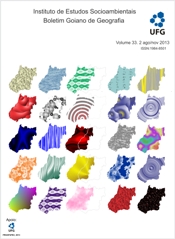ESTIMATION OF THE CASSAVA AREA FOR STARCH PRODUCTION IN PARANAVAÍ REGION, PARANÁ STATE, BRAZIL, THROUGH THE SENSOR LANDSAT TM 5 - DOI 10.5216/bgg.v33i2.25559
DOI:
https://doi.org/10.5216/bgg.v33i2.25559Abstract
The paper evaluates the use of geotechnology supporting the evaluation of cassava harvest for starch production. The research examined the possibility of identifying areas planted with cassava for industrial use in Paraná State, in the micro region of Paranavai, largest Brazilian region for starch production, through the use of images from the Thematic Mapper sensor onboard the Landsat 5. Obtaining information onthe area planted with cassava should reduce uncertainty of the cassava starch industry in the region and reduce fluctuations in the price of starch. The evaluation was divided into three steps: location of 85 planting areas and development of an identification key; verification of the forecasts and validation of the identification key; evaluation of the planted area in three municipalities and comparison with data from the IBGE. The results showed an efficiency of 95% in identifying the areas with cassava. The forecast is limited to areas greater than 2 ha, which presents no problem for the micro region of Paranavai, but can be limiting in other regions, such as the West of Paraná. Nevertheless, remote sensing is a valuable tool for predicting
production of industrial cassava. It could complement the IBGE data, which were very different.
Downloads
Downloads
Published
How to Cite
Issue
Section
License
Authors will not receive any payment for publishing their work in Boletim Goiano de Geografia. Therefore, they must grant all rights to the journal. However, they are entirely and exclusively responsible for the published contents, and editors are free to make corrections or adjustments to texts in conformity with publication guidelines.







